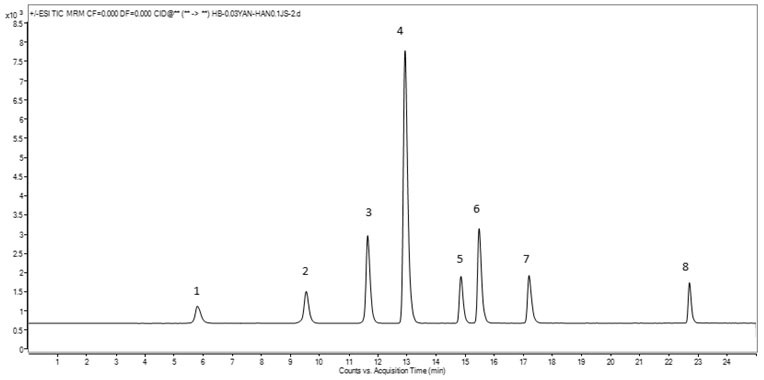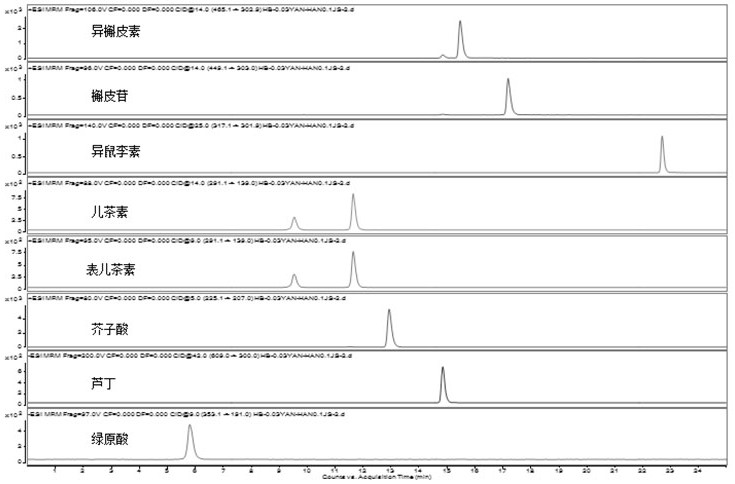Method for detecting contents of eight flavones and phenolic acid components in camelina sativa seeds
A detection method, the technology of camelina, applied in the field of chromatographic detection, can solve the problems of expensive standard products, less research on seeds, and restrictions on the practical application of multi-index component quality control, and achieve good stability and reproducibility
- Summary
- Abstract
- Description
- Claims
- Application Information
AI Technical Summary
Problems solved by technology
Method used
Image
Examples
Embodiment 1
[0044] A method for detecting the contents of 8 kinds of flavonoids and phenolic acids in camelina seeds, comprising the following steps:
[0045] (1) Preparation of mixed reference substance standard solution
[0046] Eight reference substances of chlorogenic acid, catechin, epicatechin, sinapic acid, rutin, quercetin, isoquercetin, and isorhamnetin were precisely weighed, dissolved and diluted with methanol to obtain a single Reference substance stock solution; wherein, the concentration of chlorogenic acid reference substance stock solution is 92.4 μg / mL, the concentration of catechin reference substance stock solution is 776.16 μg / mL, and the concentration of epicatechin reference substance stock solution is 40.50 μg / mL, the concentration of sinapinic acid reference substance stock solution is 42.40 μg / mL, the concentration of rutin reference substance stock solution is 970.02 μg / mL, the concentration of quercitrin reference substance stock solution is 30.0 μg / mL, isoquer...
Embodiment 2
[0079] Embodiment 2 blank test
[0080] Take 5 μL of 80% methanol and inject it into UPLC-MS-MS (Ultra Performance Liquid Chromatography Tandem Triple Quadrupole Mass Spectrometer) for determination, and record the chromatogram and multiple reaction monitoring diagram. The results showed that the solvent peak of 80% methanol aqueous solution was concentrated before 3 minutes and had no interference to the detection.
Embodiment 3
[0082] A method for assaying the content of 8 ingredients in camelina seeds, according to the steps of Example 1, the only difference is that during the preparation of the test solution in step (2), the petroleum ether extraction is changed to n-hexane extraction, and the result See Tables 5 and 6 below. Explanation of the experimental results: changing the extraction solvent did not constitute a significant difference in the measurement results.
[0083] Table 5 Determination of 8 components in camelina seeds by external standard method (ESTD) and one test multiple evaluation method (QAMS) (μg / g)
[0084]
[0085] Table 6 Determination of 8 components in camelina seeds by external standard method (ESTD) and one test multiple evaluation method (QAMS) (μg / g)
[0086]
PUM
 Login to View More
Login to View More Abstract
Description
Claims
Application Information
 Login to View More
Login to View More - R&D
- Intellectual Property
- Life Sciences
- Materials
- Tech Scout
- Unparalleled Data Quality
- Higher Quality Content
- 60% Fewer Hallucinations
Browse by: Latest US Patents, China's latest patents, Technical Efficacy Thesaurus, Application Domain, Technology Topic, Popular Technical Reports.
© 2025 PatSnap. All rights reserved.Legal|Privacy policy|Modern Slavery Act Transparency Statement|Sitemap|About US| Contact US: help@patsnap.com



